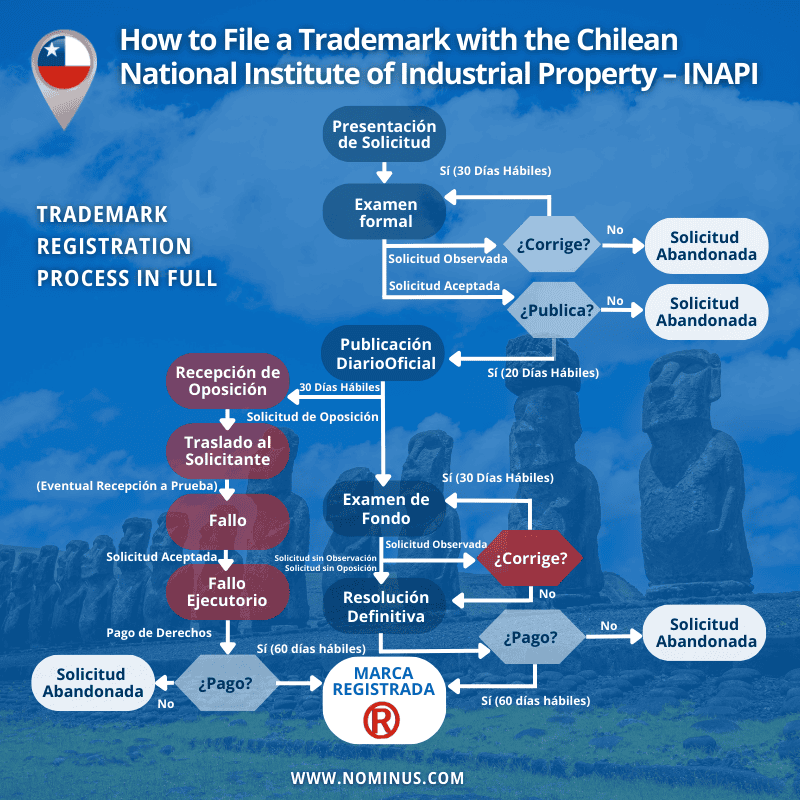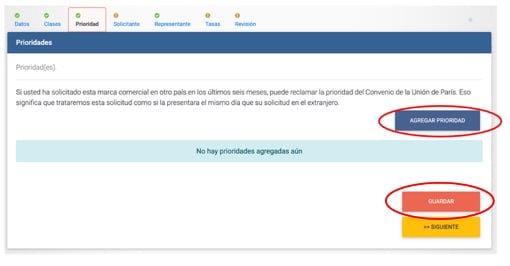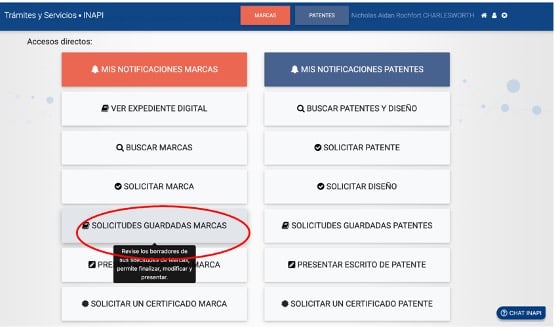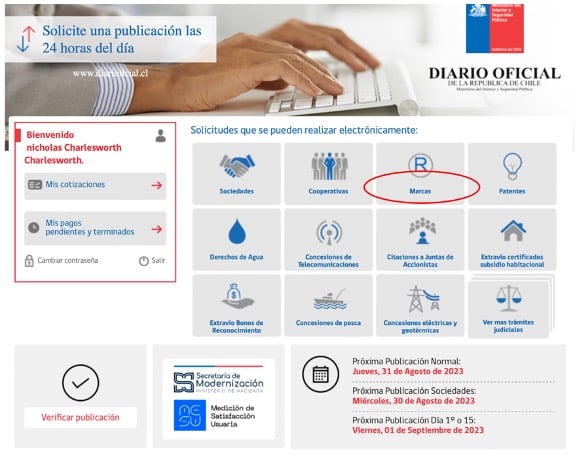How to File a Trademark with the Chilean National Institute of Industrial Property – INAPI
Introduction
Filing a trademark in Chile today is a relatively straightforward process and can be done 100% online. Keep in mind, there could be challenges that make registering your brand difficult. In this straightforward guide, we'll explain all you need to know about trademark registration in Chile. Let's review the essential points you should be aware of.
Why should you file a trademark in Chile?
Safeguarding your brand identity is an essential part of your business. And trademark registration isn't just a cost—it's an investment in your brand's success that can not only grant you strategic advantage by establishing brand exclusivity in the Chilean market, but also bring long-term benefits, improve local business prospects, and build local brand loyalty. And, perhaps most important, it can also prevent copycats and legal troubles.
Chile's economic structure is defined by a dynamic blend, combining features of both a market and a planned economy while keeping a strong focus on market-driven approaches. Chile ranks 20th globally and 2nd in the Americas in the 2022 Index of Economic Freedom. Similarly, it scored 94/100 in the 2022 Freedom House index. In short, individuals in Chile enjoy the freedom of choice in various aspects of economic activity and political engagement.
Latin America is often characterized by its intricate regulatory complexities that pose challenges to conducting business and act as barriers to growth in certain countries. However, Chile defies this norm, emerging as one of the region's most business-friendly environments. Not only does it boast a vibrant economy and solid infrastructure, but it also adopts a welcoming stance towards foreign investment.
Trademark Registration in Chile: An Overview
Trademark registration in Chile is obtained through the national patent office, INAPI. Though it provides the flexibility of in-person registration, its online system embodies a streamlined and user-friendly procedure that essentially involves 6 steps, including conducting a comprehensive search, paying the required fees, and tracking your application's progress. However, before embarking on this journey, which can take up to 6 months, it is essential to understand the distinct requirements for locals and foreigners. The protection granted by the registration of a trademark in Chile is territorial and temporal: it offers 10-year protection throughout the country, with the option of renewing registration indefinitely upon payment of the corresponding fee.
Requirements for Locals
The first step is to determine whether you wish to submit your trademark as a natural person (persona natural or under a business name as a legal entity (persona jurídica). The latter requires that you designate a legal representative to act on behalf of the company before the Patent Office with a suitable power of attorney (poder). In the Appointing a Local Representative section below, we offer some information and tips. From this point onwards, the process is uncomplicated. You'll gain access to the INAPI platform using a Unique Key, which can be obtained easily (see the next section), and then proceed to follow the sequential steps 1 to 6 outlined below.
Requirements for Foreigners
Although the steps for local applicants and foreign applicants remain the same, natural persons or legal entities residing outside Chile are required to appoint a representative domiciled within the country.
First off, you'll need a power of attorney (poder), a legal document granting someone else the authority to act on your behalf. To start, reach out to a qualified attorney in Chile to draft this document which must be in Spanish. Be sure to choose a trustworthy individual and limit their authority to the specific tasks needed. In the Appointing a Local Representative section below, we provide further details of how you can do this.
The best method, that avoids the potentially problematic foreign legalization of local notary signatures, is to locate nearest Chilean Consulate in your country to have them sign the document. Normally, you will need to send the document in advance, together with a photocopy of your passport (the person requesting the power of attorney), a money order and a prepaid envelope, and schedule an appointment. Either the Consul itself, or your Chilean attorney can help you set this up and advise you of the cost.
Once notarized, the document needs to make its way to the Chilean Foreign Affairs Office in Santiago. Here, the Chilean Consul's signature will be authenticated. This final step is crucial to ensure the document holds legal weight in Chile.
BEFORE YOU BEGIN
Before diving into the application process, be sure to have these essentials in place:
-
Unique key (Clave Única): this convenient tool unlocks access to a range of online government services and benefits. It can be acquired either in person by visiting any Civil Registry office or ChileAtiende branch (or through your local consulate for Chileans residing abroad), or by scheduling a video conference online.
-
Your brand's name.
-
Whether or not to include a logo.
-
A clear awareness of the services or products your brand will safeguard (classification).
Comprehensive trademark search to avoid conflicts
Prior to submitting your application, it's crucial to perform a trademark viability search within Chile's INAPI database. This step ensures that your proposed trademark isn't already registered or closely resembles existing brands. It is vital given that INAPI assesses trademark uniqueness and provides a window for potential opposition claims. It also ensures a fair playing field for all. Everyday words or overly descriptive terms might not pass the trademark test.
For instance, using general terms such as "Pan" for bread could hit a roadblock. Flags, state symbols, and emblems are also a no-go for trademarks and your logo can't include these elements. Even using a term like "Dulce" (Spanish for "sweet") might be flagged for being too descriptive. To navigate this landscape, you can go directly to INAPI or Empresaenundia, which both offer their own smart search tool. The latter integrates 3 checks simultaneously: websites, registered trademarks, and registered companies and societies.
At Nominus, we also offer an English version Trademark Class Search tool. By entering your product/service, it will tell you the class or classes you should register for. Once you have found your class(es), you can then use our Trademark Search engine. Be sure to try out several combinations of words and spellings in your search.
Also, keep in mind that different companies can share a name, but their classes must differ—trademarks are awarded based on classes, not names. Ensuring your trademark covers the exact products or services you intend to apply for is vital.
Conducting a thorough Trademark Search can be challenging and time-consuming. To make this easier, we also offer a Trademark Study service. The Study will provide details about the classes where you might wish to register your trademark, as well as a list of identical and similar trademarks. Lastly, it will provide an Attorney's recommendation about registration possibilities and use of your trademark.
Armed with these insights, you'll embark on your trademark journey with confidence, ready to navigate the twists and turns of the branding landscape.
Types and Categories
When it comes to registering a trademark in Chile, a clear grasp of your brand's identity is essential before hitting that submit button. The building blocks of a trademark encompass numbers, letters, images, or a fusion of all these elements. Let's break it down:
-
Categories
-
Different types of trademarks serve various purposes in the market. A standard trademark sets your product or service apart. Propaganda phrases enhance promotional impact, while collective brands, such as traditional regional products distinguish offerings from non-members. Certification trademarks assure third-party products meet certain standards of quality in terms of production, materials, and/or location.
-
Types
-
There are various trademark types you'll need to define, with the most common being words or denominative marks. However, you can also explore other options, such as figurative marks with visual elements, mixed marks combining words and visuals, and sound marks that rely solely on auditory elements. Each type offers a distinct way to define and protect your brand identity.
Be sure your chosen trademark aligns with your brand's identity before diving into Chilean trademark registration.

Fig.1 Trademark registration process in full.
Filling out the Trademark Application Form
Step 1
To lodge a trademark application, navigate to INAPI and click on Accesos.

Then click on Marcas and Solicitar Marca

You will then be required to enter your Unique Key.

If it's your first time, you will need to register your details with INAPI. You will be asked to confirm by email.

Once you have confirmed your email to verify your account and logged in using your Unique Key (see Before you begin section), select Solicitar Marca to begin your application process.

Filling out the online form
First, you will then need to define the category, type of brand and the brand name (please see the types and categories section above).

Step 2
In addition, you're required to provide a textual description of your brand's label. If your brand includes a word in a language other than Spanish, you must also provide its literal translation and a transliteration if the words or characters are different to Spanish.

Here you must first search for and then select the type of coverage (product, service or product and service). This is a crucial part of the process. You'll need to determine the specific classes or categories in which you intend to protect your trademark. These classes, categorized according to the international Nice Classification, encompass various economic activities.
Keep in mind that trademark protection is specific to a particular economic activity, which means that brands can coexist even if they operate in entirely different domains. For instance, the term "Horizon" may be found in "Horizon Travel" in the context of a travel agency but might also be used by a tech company called "Horizon Tech Solutions".
To help you, there is also a new version of product and services classifications available in English.

The results of your search will appear below the search tool. Here you must add the description or coverage that applies to your brand. These will be shown below and can be edited using the pencil tool. Please note that each class is charged additionally.

If you've applied for the same trademark in another country within the last six months, you can invoke the Paris Convention priority. This means we will process your current application as if you had submitted it on the same day as your foreign application.

You should then enter details about the applicant, whether a natural person or legal entity. If you have appointed a legal representative, continue to the next section (Representante).

If you have appointed a legal representative (see the Section on Requirements above), you will need to enter their details here:

Once you're confident about your application, you'll need to make an initial payment for each class you intend to register. Please consult INAPI's website for the most recent cost structure. If INAPI rejects your application for any reason, this first payment will be upheld for fiscal purposes. It's a safeguard to ensure that the financial aspect is accounted for even if the application doesn't proceed as planned.
First complete your payment details (whoever is to pay the fee) to receive a receipt from the Treasury (TGR).

Before making the payment, you will be given a chance to review your form and make any necessary changes to each section of the form. Once you are confident with your application, click on make payment and submit (Pagar y Presentar Solicitud).

You will then receive confirmation of payment and a notification saying that your application has been submitted for initial evaluation.
STEP 3
Once your application has been given the green light for processing, you'll be sent a notification by email indicating that you have a span of 20 business days to make your trademark registration request official by publishing it in the official gazette using the INAPI Request number (No. de Solicitud).


Remember, missing this payment window could lead to INAPI regarding your application as if you've decided to withdraw it. There's also a chance that INAPI might have some observations to share regarding your application. These observations often arise from simple errors made during submission. Should you find yourself in this situation, you'll be given 30 business days to rectify them.

STEP 4
Once your trademark request has been published in the official gazette, there's a 30-business-day period during which anyone can raise objections to your application. If an opposition claim is filed, INAPI will issue a "notice of opposition," (Demanda de Oposición) allowing you 30 business days to provide your response. To respond to such oppositions, you are required to appoint a qualified legal representative. This phase requires careful consideration and preparation to ensure your application proceeds smoothly.
STEP 5
Regardless of whether an opposition has been filed, INAPI will conduct a substantive examination to verify that the trademark application does not incur any of the legal grounds for unregisterability. If everything is in order, they will issue an acceptance resolution for registration. Upon receiving this resolution, you will need to make the final payment for each class you wish to register within a timeframe of 60 business days.
On the flip side, there's a possibility that INAPI might issue a substantive examination observation on your trademark. This means that INAPI believes there may be a reason your trademark does not meet the suitable standards of registration. If this happens, you'll have 30 business days to present written arguments that could encourage INAPI to reconsider their decision. In this event, it is again advisable to seek legal assistance.
If, in the end, INAPI rejects your trademark, you'll need to appeal to the Industrial Property Tribunal (T.P.I) and this must be conducted with the legal representation of an attorney.
Monitoring the Application
Regularly monitoring the progress of your application is essential to avoid overlooking time-sensitive obligations or protocols. Failure to do so might result in your application being considered abandoned or untreated, due to standard legal procedures.
You can check the status of your application on INAPI´s digital platform:


Appointing a Local Representative
When it comes to foreign applicants looking to register trademarks in Chile, a crucial step is to designate a local attorney or representative within Chile. This appointed representative will take on the responsibility of guiding the foreign applicant through the entire trademark registration journey and acting as the official liaison with the Chilean National Institute of Industrial Property (INAPI). With their adept understanding of Chilean trademark laws and regulations, the local representative will ensure a seamless and compliant application process.
The designated local representative will undertake the following tasks:
-
Conduct a Comprehensive Trademark Search: The local representative will meticulously assess the availability of the proposed trademark and ensure it doesn't infringe upon existing ones.
-
Access and manage the INAPI online application tool: By utilizing their credentials, the local representative will obtain access to INAPI's online form.
-
Fill out the Application Form: It's the responsibility of the local representative to accurately fill out the application form on behalf of the foreign applicant, including pertinent details about the trademark and its associated goods or services.
-
Handle Fee Payments: The local representative will oversee the payment of registration fees.
-
Monitor Application Progress: The local representative will keep tabs on the application's progress and effectively address any issues raised by INAPI.
-
Receive the Trademark Registration Certificate: Once the review process has proven successful, INAPI will issue the applicant with the trademark registration certificate, while the local representative will remain the official point of contact for any future trademark-related matters.
Benefits of hiring a Local Attorney
Enlisting the services of a local attorney in Chile to oversee the trademark registration process offers a range of benefits:
-
Expertise: Local attorneys well-versed in intellectual property laws bring profound insights into the registration process, navigating adeptly any potential obstacles.
-
Language Bridge: Having a local attorney proficient in both Spanish and the applicant's native language ensures clear and effective communication with INAPI, minimizing misunderstandings.
-
Legal Advocacy: In the event of any legal disputes or oppositions, a local attorney can stand up for the applicant's interests, providing legal representation.
-
Enhanced Efficiency: The registration process can prove intricate and time-consuming. A local attorney can expedite proceedings while ensuring all prerequisites are met punctually.
If you're on the lookout for a streamlined trademark registration experience in Chile, Nominus.com presents a reliable and effective solution. Leveraging the expertise of local attorneys, Nominus takes charge of the entire process on your behalf—from conducting comprehensive trademark searches to meticulously handling application submissions and closely monitoring their progression.
Conclusion
Chile's prominent economic standing in Latin America underscores the benefits of a local trademark registration. By protecting your brand here, you tap into a range of opportunities. Chile's consistently high ranking in the region for its business-friendly environment, makes it a strategic hub for companies looking to expand. Your registered trademark is not just a legal asset; it's a valuable key that can open doors to partnerships, investments, and new markets throughout Latin America.
Ensuring the protection of your trademark through Chile's National Institute of Industrial Property (INAPI) is a pivotal step in safeguarding your brand's distinctiveness and intellectual assets within this dynamic marketplace. Whether you're a local entrepreneur, representing a company or an international player, it's crucial to comprehend the unique prerequisites applicable to each category. Given the process might appear somewhat daunting at first glance, contemplate streamlining your trademark registration journey by engaging and partnering with local attorney or reputable service provider such as Nominus.
Making sure to conduct a comprehensive viability search and adhering to INAPI's guidelines on trademarks will pave the way for a successful registration process, allowing you to confidently protect your brand within Chile's vibrant business landscape.
Whether you choose a hands-on approach or the convenience of a local attorney or service provider, we hope you have a clearer understanding of INAPI's trademark registration process. You should now be well-prepared to preserve confidently your brand's identity and capture the benefits and opportunities available to established businesses in Chile.